Simon Says on-premises Enhanced AI installation
To purchase Simon Says on-premises Enhanced, see here.
If you are looking for a different Simon Says product (we have cloud and on-premise products), see here.
On-premises Enhanced | AI Installation instructions
Note: there are two parts to the On-premise Enhanced solution:
- the artificial intelligence language model (A.I.) which runs in the background on a Linux computer or on a Mac/PC with a virtualization software.
- the Simon Says Graphical User Interface (GUI) software, which runs on Mac, PC, and Linux desktop/laptop computers, where you import files, transcribe, edit/annotate the transcript, and export it.
Prerequisites:
- Ideal computer specifications (if you are running both AI and App on the same machine): 4-core CPU, 32GB RAM, 20GB of hard drive space
- Installed: VMWare Fusion (Mac) (free for 30 days), WMWare Workstation (PC) (free for 30 days), or some other virtualization software such as Virtual Box. Or you have a Linux machine.
- Ports 3000, 8080, and 8082 are open.
Supported imports: most audio/video file formats/codecs.
Recommended import settings:
- MP4s as it will lead to the quickest transcription. If you are transcoding your files in advance of importing to Simon Says, low/medium resolution video with high quality mono audio is fine as the emphasis is on audio for transcribing.
- MOV H264 if you need to preserve timecode for your video editing applications.
Watch the video walkthrough of setup and your first transcription:
Getting Started: Installation and Activation
- Open VMWare Fusion/Workstation or your Linux machine and import Simon_Says*.ova. This file is the artificial intelligence software that runs in a virtual machine in the background of your computer. It can take awhile to load the ova file for the first time. Once it loads, we recommend editing the “Virtual Machine settings” and assigning it at least 16GBs of RAM and 50% of the available CPU cores of your machine. Then run the virtual machine. **If you are running VMWare Fusion 12, you may need to uncheck the "Enable code profiling applications in this virtual machine"on advanced options of the processors area to be able to install the .ova.
If you are having trouble with VMWare, use Virtual Box
- We suggest waiting 5-15 mins before continuing as the VM machine needs to register an IP address (time depends on machine specs/configurations). This IP address is used by the Simon Says GUI app (which we install in the next step) to access the AI software and transcribe your files.
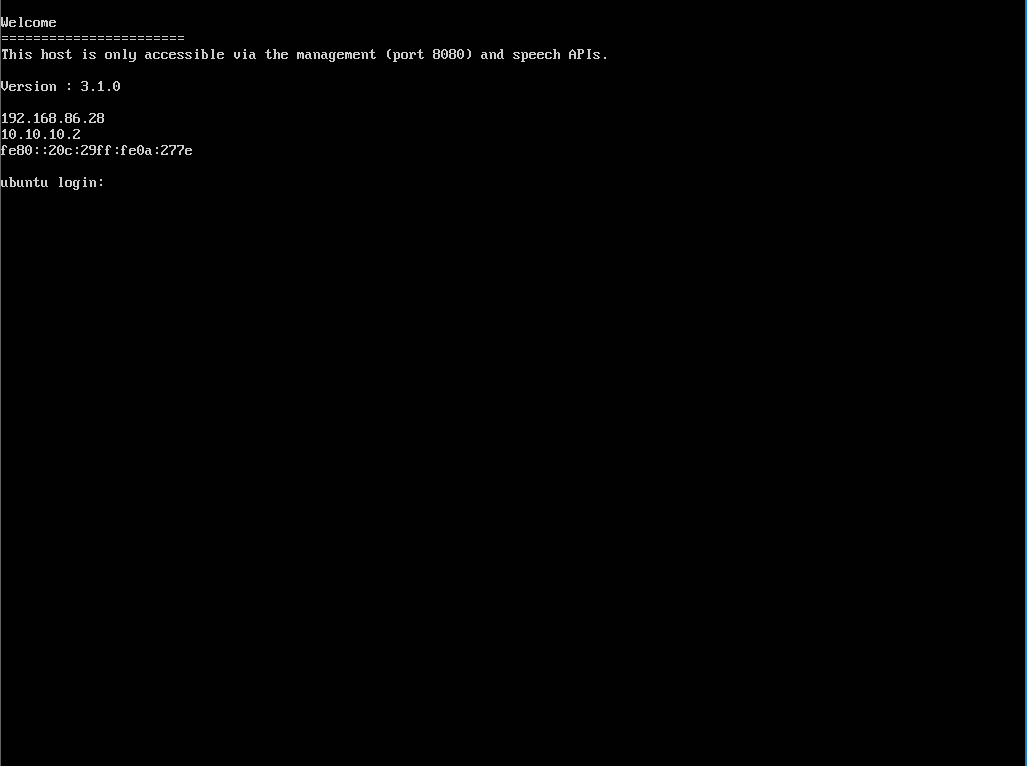
3. Uncompress the zip/dmg file to install the Simon Says GUI application on your computer.
4. Open the Simon Says application. Go to the Application main menu, “Preferences” submenu, and select “Configure Service IP”.
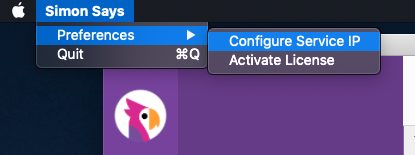
5. Enter the IP address from the A.I./Virtual Machine into the "Configure Service IP" box and click OK. Below: Screen 1 is a screenshot of the virtual machine; screen 2 is a screenshot of the Simon Says app:
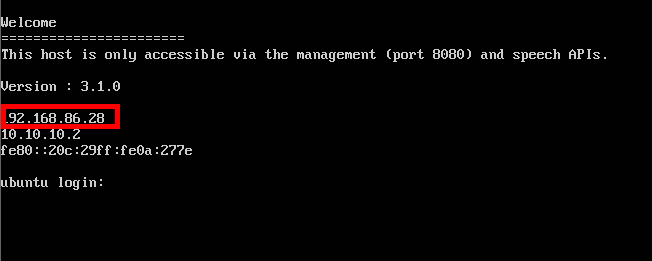

You can also check the Virtual Machine is up and running and the IP address is registered by going to your browser and entering http://192.168.86.28:3000/ where “192.168.86.28” should be replaced with the IP address you see in the Virtual Machine. Getting the Virtual Machine to register its IP address so the Simon Says GUI app can see and interact with it is the most difficult step in this entire process.
6. Then go back to the “Application” menu, “Preferences” submenu, and select “Activate License” and enter your license number. If all worked, you will see your credit total in the footer of the middle pane. (Click arrow to reveal middle pane.) Note: ideally you have an internet connection for the license activation step. If you are without on air-gapped computer, contact support to activate license.
You are ready to Transcribe! Wooohooo!
Getting Started: your first AI transcription
Both the virtual machine with Simon Says AI and the Simon Says GUI application need to be running and connected. You can see that the Simon Says GUI App is connected to the AI by viewing the footer of the middle pane. If it is connected, it will show # of hours remaining. We recommend closing all unrelated and non-essential programs that are intensive on CPU and RAM so the Simon Says AI and GUI application have the optimal resources.
We recommend trying a short video first to make sure the file type/codec processes, transcribes and exports as expected. This is so you don’t unnecessarily waste a lot of credit. You will then feel comfortable transcribing longer and larger quantities of files.
- Click + icon to create a new Simon Says project.

2. Drag and drop your audio and video files onto the import box or click the import box to select your files.
3. When you have imported all the files you want to a Simon Says project, click “Transcribe” and click OK to begin. Transcription will commence. Length of time to complete the transcription varies based on your machine configuration (ie faster your computer, faster the transcription). See the recommended computer specs.
4. Transcription is complete! You can edit this page. Add bookmarks and notes. To switch to a new file in that project, click the down arrow by the file name on the toolbar.
5. When you are ready to export, click “Export” and a zip file will save in your Downloads folder. Unzip and then import your files into their respective program. See here for instructions to import to your NLE.
TaDa!
A visual guide: the features of the Simon Says transcript editor.

- The Simon Says transcript page is like a Google Doc: go ahead, edit it.
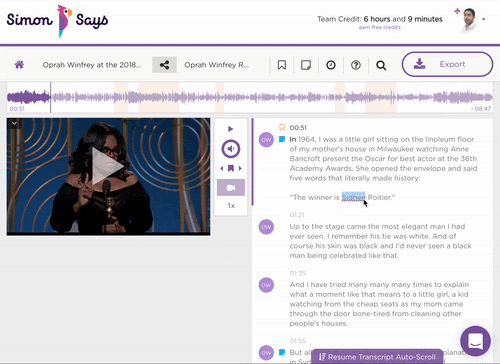
You can even edit the project name.
2. Create new rows; they will each have their own timecode.
3. Click > to add and set speaker labels.

4. Jump to specific points in the audio / video by clicking the time above the row or at points in the waveform.

Or by using the keyboard shortcut CTRL + mouse click on any word in the transcript.
5. Increase / decrease playback speed by clicking the button on the player. You can also use the keyboard shortcut: CTRL + , to decrease the speed and CTRL + . to increase the speed.

6. Set the start timecode and frame rate by clicking the clock icon on the toolbar. This function is often important for those in video production.
Note: Simon Says auto detects timecode for many different file formats and automatically sets it.
Note 2: You cannot adjust the timecode of individual words or rows; you can only set the start timecode/frame rate for the whole file which will automatically adjust the timecodes for each words.

7. Bookmark your selects (you can also use the keyboard shortcut CTRL + b) and use the bookmark filter to focus your transcript.
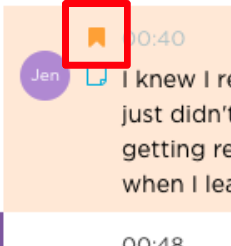
Click the bookmark icon to bookmark a row:

Bookmark filter on the toolbar to see only your bookmarked rows:
8. Annotate as needed and use the annotation filter to focus your transcript.
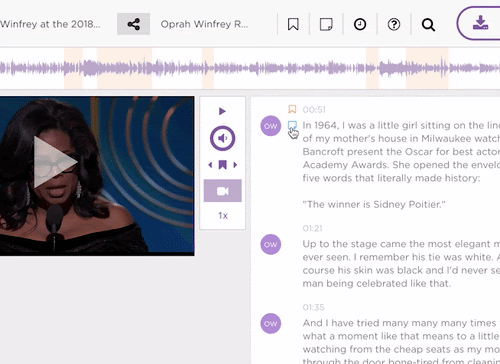
Annotation filter on the toolbar to show only the rows with notes:

9. Search for keywords in your transcript by using the search button. It’s the magnifying glass icon beside the Export button.

10. Switch between files: click the down arrow beside the file name to switch between files and their transcript in your project (if you uploaded more than 1 file into that project).
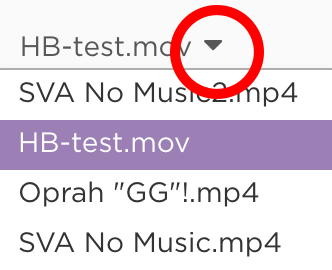
11. Save time with our handy keyboard shortcuts. Click the ? icon on the toolbar.


12. Click Export and your exported ZIP saves in the Downloads folder.

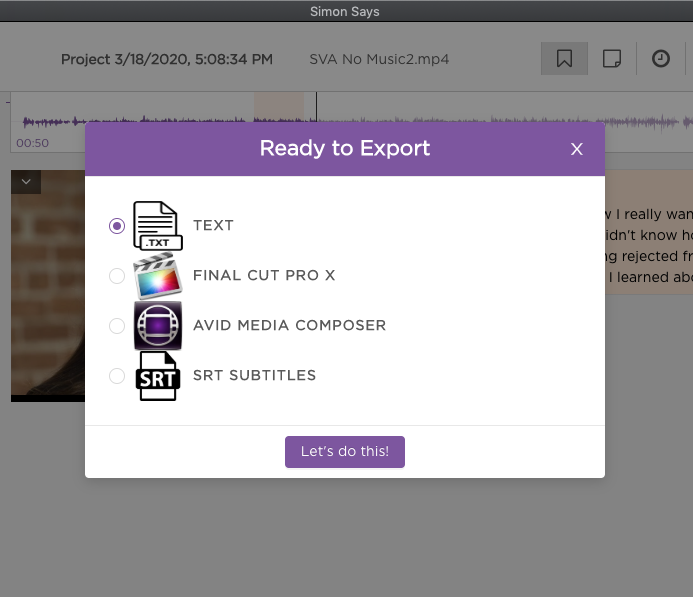
_oOo_
Notes:
- File compatibility: use MOV if you want to preserve timecode through transcription and to export. Use MP4 if you want to optimize for transcription speed (MP4 does not support timecode). If you encounter an error importing your files, you will need to transcode it to a compatible format first before using Simon Says.
- Export: Simon Says supports export to a broad range of formats including text, Word, Excel and numerous NLEs (such as FCPX, Avid, and Adobe Premiere/Audition). The available export options in your application depend on which ones were agreed upon when you signed up for Simon Says on-premise application.
- How long does transcription take: it depends on your CPU speed/computer specs. Average: less than 50% of the duration of a file.
- If you are running this application on a laptop and moving locations, we recommend suspending the virtual machine before moving. Moving locations changes the IP address and it is best to suspend the VM and then restart it at the new location. When you restart in a new location, you will need to reconfigure the IP address again.
- Expiry: A license expires 12 months from activation.
Troubleshooting:
If you have trouble transcribing:
- Restart the Simon Says GUI app and try again.
- If you are still having issues, restart the virtual machine. Once it loads, it may need 5-15 mins to register its IP address on the network. Then restart the Simon Says application and see the Configure Service IP box to make sure the IP addresses match.
- Check that you have enough credit. If you need more credit, contact support; hello@simonsaysai.com
- If your virtual machine has a corruption error, we recommend reimporting the *.ova file from scratch. You will lose any hours allocated to the original OVA when you re-import the OVA as credit does NOT transfer over.